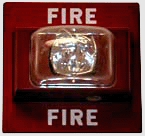| Resources & Facilities Safety Main Evacuation Plan: R-A-C-E Emergency Procedures People FAQ Bulletins |
 Move to safety when flashing.
Frequently Asked Questions:What is so dangerous about Hydrofluoric Acid? HF is one of the most dangerous reagents used in the department! Geologists use it to etch or dissolve silicate rocks, and containers of HF can be found in many of our labs. HF is highly toxic if swallowed, absorbed though the skin, or contacted by the eyes or mucous membranes. Even a tiny amount on your bare skin can result in an extremely painful burn that unless treated will quickly penetrate the skin to attack tissue and bone. Internally the fluoride binds with calcium ion, disrupting the electrical conductance of your heart. With concentrated HF, exposure of as little as 2% of your body surface (like, your hand) can be fatal if not immediately treated, and once the HF is absorbed there is almost nothing anyone can do - you will simply die. The only effective treatment is Calcium Gluconate gel - when applied quickly after exposure it can have a dramatic effect. Please see the bulletin from Harvard's web page, and the article. What should I wear when I use HF? When using concentrated HF, you must work in a fume hood. You must wear safety glasses (goggles are better), a lab coat, and the correct gloves - I would recommend double gloves. Whenever HF is being used, you must have within easy reach a tube of Calcium Gluconate gel. If you get HF on your bare skin, you should immediately wash the exposed area with copious amounts of water for a few minutes, then quickly apply the Calcium Gluconate. When do I have to wear safety glasses? Anyone working in a lab where there is a potential splash hazard, possibility of rupture, etc. must wear protective eyewear, even if you are not actually working with that material. Since you can't control what other people are doing in the lab area, everyone must wear protective eyewear. This is not a matter of choice, it is a condition of employment. (UT-OEHS Bulletin) Are my prescription eyeglasses "protective eyewear"? Generally not. Most prescription lenses are not at the level of impact resistance required, and they do not have top or side protection. If your lenses meet the specification for impact resistance, it is possible to put on side-shields, but this is a pretty thin alternative. We have available safety glasses that fit over prescription eyewear that fit pretty well, and look great.... Where do I get my safety glasses and goggles? Thought you'd never ask.... UT-DOGS students needing their first pair can get them from their supervisor - they must be provided to employees working in an area that requires them. What should I wear in a laboratory? First, what you can't wear - open-toed or open-heeled shoes or sandals! Bad idea when things are dropped or spilled. Other than that, if you are wearing shorts or short-sleeved shirt, you need to wear a lab coat. Some students keep a pair of "scrubs" to wear in the lab, and a pair of old running shoes. Don't worry, hyperthermia is probably not a problem in our building...(UT-OEHS Bulletin) What type of gloves should I use? This is not an easy question with a single answer - it depends on what you are working with, and what the exposure scenario is. As a general lab glove, or as an inner glove, I would recommend heavy nitrile - they have good chemical resistance, do not tear easily, and will not promote latex allergy. What is the difference between calling 911, and 9-911? When you call 9-911 from a campus phone, or 911 from a cell phone, you are connected directly to Austin's emergency dispatch center - from there you can talk to a Law Enforcement, EMS or Fire dispatcher. This is the quickest way of getting help for medical, fire, or rescue emergencies. When you call 911 from a campus phone, in contrast, you are connected to the UTPD dispatcher. While these dispatchers are highly trained, will take the necessary information, and contact Austin Fire Dept. and EMS, it is an extra step for these emergencies, and can delay response. However, if you call 9-911 for emergency assistance, and there are other people assisting the patient, then you should next call 911 (UTPD) - an officer can respond very quickly and help with directing the responding AFD/AEMS units, crowd control, and in some cases, provide first-responder patient care. What should I do with old reagents that are no longer used? Get rid of them! There is no reason to hang on to out-of-date reagents "just in case", and some good reasons not to. Old reagents can decompose to form toxic or reactive byproducts, or byproducts that will have an unexpected reaction when mixed with something else. OEHS will come and collect old chemicals still in their original bottles and dispose of them appropriately. Take a look around your lab - you might be surprised at what you find, and at how much room you will gain when you get rid of that stuff. OEHS is available to help clean out a lab if you do not have the information necessary to fill out the disposal form. What does OEHS look for during the laboratory inspections? The OEHS inspects Geological Sciences annually in late summer. The inspection criteria is a bit of a moving target as the system matures, so the best idea is to 1) complete a laboratory self evaluation every year, in the Spring or early Summer; and 2) check the OEHS web site with the inspection checklist. OEHS has a new director (effective 11/98), so I suspect the system will see some additional changes in the next few months. Where can I get more information? The UT Office of Environmental Health and Safety (OEHS). The department's lab safety contact is Dan Breecker (breecker@jsg.utexas.edu ). |
|
|